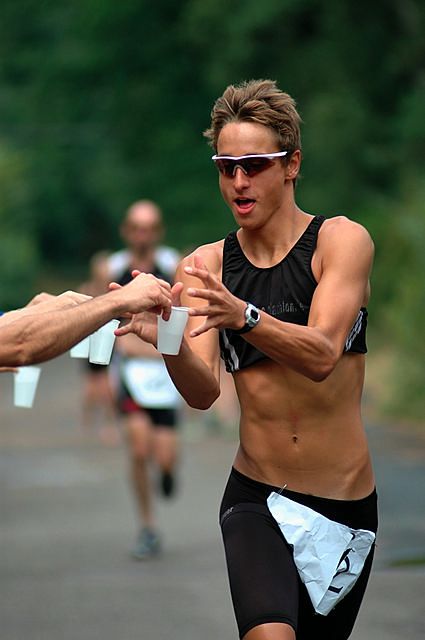No unfortunately I decided not to join the race this year. This has been on my list this year but due to something that came up I decided to drop this race. I could have still push to join it, but it was just really impossible for me to be there. Looking at the finish time of my friend who joined the race, I though it was a right decision that I did not push to be there. With my training and how I perform in some of the races, I am not too sure if can really make it.
With an intention of trying my luck again next year, I want to keep a copy of the analysis of this great runner for my personal reference.
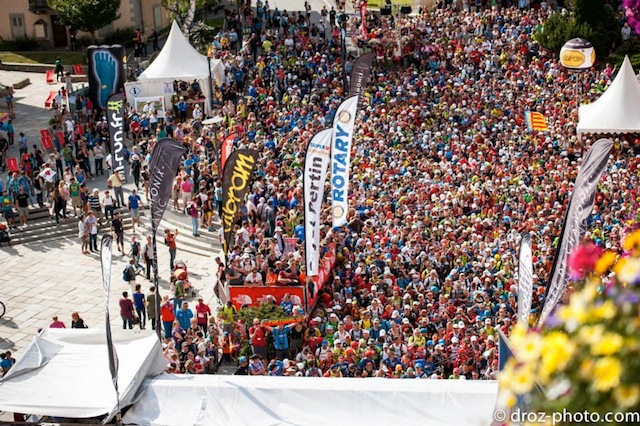
Photo: Salomon Runinng (Damien Rosso).
I dropped from the 2013 Ultra Trail du Mont Blanc in Trient,
Switzerland on Saturday morning—139km and 17hr after the start in
Chamonix, France, but still 29km from making it all the way around the
mountain. Curiously—despite the DNF—UTMB was one of the most pleasant,
even serene, racing experiences I’ve had out on the trails. However,
sometimes a few pieces of gristle are all it takes to bring a halt to
our silly ambitions, and, if you let it, completely transform your
outlook on the day. I’ve tried to not let that happen, but I’m a
competitive bastard, and it takes constant attention on my part to keep
my perspective firmly situated in the much-vaunted “bigger picture”.
Sometimes you really want to win the fucking race, though. Or just
finish, even. And when you don’t, it’s disappointing. Big surprise.
Like anyone, I’d heard all the stories of
UTMB’s rampaging opening pace and over-the-top starting line pageantry,
so in the days—months, even—leading up to the race, I continually
reminded myself of the need to begin conservatively. I’ve ruined at
least three 100mi races in my career by being overzealous in the first
half, and I desperately wanted to avoid that here. I knew I was fit;
success was going to come down to a matter of attentive race-day
execution.
Upon arriving in Chamonix three weeks ago, objective number one was
to preview the track by running from town to town around Mt. Blanc.
Doing so allowed me to experience the entire course, but I also
aggravated the backside of my right knee—the one that I hyperextended
and whose fibula I broke two years ago—on the 20km/5000′ drop from Gran
Col Ferret into Praz de Fort in Switzerland. Obviously, this section
alone wasn’t the sole culprit—injuries are typically the result of
accumulated stress—but I knew this long, gradual, fast-running downhill
would likely end up being the deciding factor in my race two weeks later
(and it was). Of course, in compensating for my locked-up hamstring I
also managed to inflame my left achilles tendon.
I took three days off after the tour around the mountain and was
extremely fortunate to meet Graeme Waterworth—a physio from Boston
running UTMB—for a pair of extensive rehab sessions before the race.
This all helped a great deal, and I did the best that I could to
willfully squelch any doubts I had about the soundness of my legs, but
if I was being honest with myself I knew my wheels weren’t entirely
100%. Racing 100mi through the mountains as hard as you can is all
about irrational confidence and optimism, so I didn’t have much use for
acknowledging any chinks in the armor.
UTMB’s format presented me with many new race logistic
wrinkles—mandatory equipment that required wearing a race pack, a 4:30pm
start time, running through an entire night, etc.—and I came out the
other side pleasantly surprised to have thoroughly enjoyed all of these
things. Wearing a pack made the 5-6hr gaps between crew access almost
trivial as carrying 20-25 gels at a time was a non-issue; I never even
came close to running out of fuel. The afternoon start meant that I
slept like a rock the night before, essentially with zero nerves (with
American pre-dawn start times I usually only get an hour or two of
fitful snoozing). And running through the entire night was a total
blast—my lighting system worked flawlessly and I never got drowsy, only
ingesting caffeine from the odd gel and a few ounces of Coke along the
way. In fact, I almost preferred the night—I found it much easier to
stay present in the moment when your world is essentially defined by the
beam of your headlamp.
I’ve never experienced anything like the race start. Electric doesn’t
even begin to describe it. Sure, it’s part Euro dance party, part
claustrophobia, part melodrama, but beneath all that is a palpable sense
of everyone being in this thing together, all striving toward the
common goal of getting around the hill as quickly and efficiently as
possible. It’s hard to find communal activities with that much positive
energy bouncing around and I think it’s important to not trivialize
that. It’s pure craziness, in the best possible sense of the word.
Despite that, I found it quite easy to quickly settle into a
reasonable, comfortable rhythm. For me, it’s easy to be conservative
when the pace is clearly ridiculous. It’s usually harder for me to
maintain that patience, however, after the initial energy has died down
but dozens of kilometers still remain before the real racing begins.
During the couple kilometers of road before hitting the trail I fell in
with the TNF triumvirate of Mike Wolfe, Mike Foote, and Jez Bragg. Once
we funneled onto the trail, the humid early evening air of late summer,
long shadows, and jockeying of pack running all immediately transported
me back to early-season cross-country races in high school. The positive
vibes were sky-high for me.
In Les Houches, at the base of the 2500′ bop up to the Col de Voza,
the Wolfepaw and I finally trotted past Nuria and Emma—the lead women,
both of whom I’d been sharing a house with for much of the time leading
up to the race—at the base of the steep stuff and settled into a nice
rhythm of easy jogging and purposeful hiking. Unsurprisingly, I could
already feel the hamstring tightening, but I knew there wasn’t really
anything I could do about it so just pushed it out of my mind. We were
effortlessly passing loads of people and I generally felt great,
especially as we ascended into cooler temps.
By the top of the hill, I’d gapped the Paw and was even beginning to
catch occasional glimpses of Seb and Miguel far up ahead, so I didn’t
feel any need to be going any faster. The downhill into Saint Gervais
(21km) is weird. It doesn’t really look that steep, but it definitely
feels steep, and awkward. It’s at just the most awkward grade where one
still employs a real running stride, but doing so imparts some serious
pounding on the quads. It felt awkward when Joe and I recced it and it
felt even more so now with a gimpy hammy.
Town was a blur of screaming crowds, but I do remember passing Seb in
the aid station. I was surprised to see him that far back, and,
unfortunately, he wasn’t feeling well and would drop at Les Contamines.
The trail from Saint Gervais to Contamines rolls gradually up the
valley, and there’s very little hiking in this section except for a
couple short, steep bops. I remember getting a little annoyed and
worried about my hamstring, but soon enough I emerged into the madness
of the Contamines aid station, the first place to see my crew. I chugged
two bottles of water, Joe traded my sunglasses for headlamps, informed
me that I was 12min off the lead (Julien Chorier), stuffed my pack with
gels for the next five and a half hour section to Courmayeur, and I was
off. I gained a little boost from seeing Timmy leave the aid only a
minute or two before me, but I was most excited to get to the real
climbing at Notre Dame de La Gorge so I could do some hiking and
de-stress my hamstring.
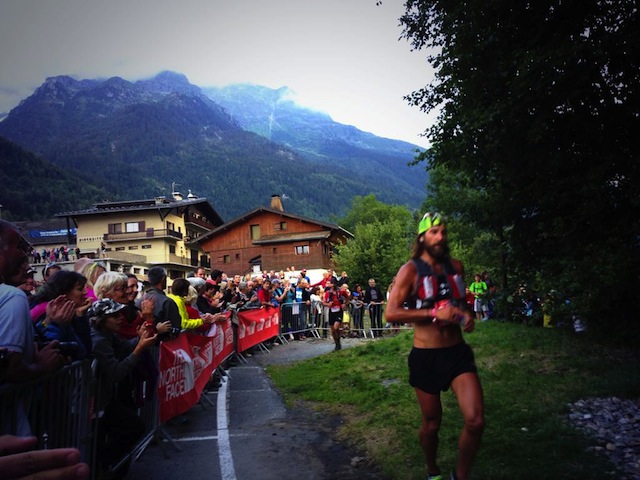
Crowds in Contamines (30km). Still about 12min off the lead and in 20th place or so. Photo: Bryon Powell/iRunFar.
I caught a couple more runners on the run to the base of the climb,
but once on the hill I really started moving through the field. Notre
Dame was a magical scene with campfires and burning stumps lining the
bottom of the hill. I saw my friends at
Buff
a little ways up, which provided another boost, and once the real
hiking started at the La Balme refuge I was so excited to finally be on
my preferred terrain of alpine singletrack.

Marching up to the Col du Bonhomme. Photo: Salomon Running (Damien Rosso).
Before I clicked on my headlamp, I caught up to Kiwi Vajin Armstrong,
tapping away with a pair of sticks. Vajin is always uber-positive and
here in the middle of the night on a mountain pass in France was no
different. He’d missed his crew at Contamines but was cheerily headed to
Courmayeur with his back-up lights and without his preferred energy
food. We chatted briefly, wishing each other luck, but most importantly
he gave me some unexpected but very encouraging news…passing him put me
in 8th place (up from 32nd only 20km earlier) and he claimed within 6min
or so of the lead. Good to know, especially since I felt my efforts in
the alpine were even more comfortable than the lower-altitude flat
running we’d been doing.
I reached the summit of Col du Bonhomme at 9:06pm amidst a thick fog, but Dave James (there reporting for
iRunFar)
confirmed that the leaders had come through at exactly 9pm and Timmy
was only a minute or two up. I caught another runner on the moderately
techy, 15min, ascending traverse over to Croix du Bonhomme and then
began the 1000m vertical drop to Les Chapieux at 49km.
The top half of this was a blast—lots of rutted cow paths to choose
from—and I passed Timmy here and caught up to Jonas Buud, but the bottom
half was an endless stretch of long, sweeping, gradual switchbacks that
wrecked my hamstring as Jonas disappeared back into the dark. By the
bottom I was cramping in my hip flexor from the compensation, but it was
impossible to be in a bad mood with the atmosphere at the aid and the
fact that I could see three lights stretching out on the 30min of paved,
runnable uphill to the base of the Col de La Seigne climb.
I didn’t actually catch anyone on the road, but once we hopped onto
the gradual uphill trail that leads into the steeper switchbacks heading
up to the Col, I passed Jonas and easily caught up to Julien who was
running with two others. Julien tucked in behind me, leaving the other
two behind, and we quickly bridged up to the leading duo of Xavier
Thevenard and Miguel Heras. And just like that, I was in the lead group
of UTMB.
Upon reaching Xavier and Miguel, the pace slackened noticeably
(Xavier was in front setting the tempo with a pair of sticks, with
Miguel hands-on-knees dutifully marching behind) and I was happy to
settle in to what felt like a very casual effort. In our quartet, it
seemed that Miguel and I were climbing the strongest as we were
constantly having to rein ourselves in from clipping Xavier’s heels and
it seemed like Julien was sort of reluctantly tagging along, like if he
were on his own he’d be climbing a touch slower. For my part, I didn’t
care if we started walking on our hands; Miguel and Julien were the two
guys I was probably most concerned about leading up to the race and as
long as I was within reasonable contact of them, I was happy. Of course,
Xavier would actually go on to win the race.
Our walk to the top of the hill was very nice. Unlike Col du
Bonhomme, Col de La Seigne was crystal clear with brilliant stars and
nary a breeze. Although the four of us were literally always within an
arm’s reach of each other—usually closer—not a single word was spoken
the entire way up, nor on the descent to Lac Combal and the Arete Mont
Favre climb. Out of the Lac Combal aid, Miguel assumed the pace-setting
duties and Xavier must’ve lingered longer in the aid because he didn’t
catch back up until the descent off Mont Favre down toward the aid
station at the Masion Vielle refuge.
At the beginning of the Mont Favre climb, Miguel sort of awkwardly
stumbled and I found myself in the front, so I set the most relaxed
tempo possible that wouldn’t have been comically slow—I was determined
to stick with my plan of patience. Miguel and Julien seemed content to
just follow. On the downhill, however, I purposefully went even more
easy so as to baby my hamstring. Finally, a couple of minutes before
Maison Vielle, Julien asked to go past and the four of us immediately
launched into a much more frantic pace on the rest of the (now steep,
tight, and dusty) descent into Courmayeur, the de facto half-way point
at 78 kilometers.
I again quickly chugged water and re-stocked gels with my crew at
Courmayeur, and with nothing better to do, jogged out of the gym in the
lead. Miguel caught up a few seconds later and we navigated our way
through the silent streets of town toward the 2500′ grunt up to the
Bertone checkpoint. Once we hit the trail I let Miguel take the pace as
he seemed determined to push the pace on this hill and open a gap on our
pursuers of Julien and Xavier. I could hear Miguel breathing heavily
and thought it was a little early to be going so hard, but my effort
felt easier than Miguel’s sounded, so we marched our way up the dark
switchbacks in tandem, reaching Bertone together and continuing on as
such for the rolling traverse over to the Bonatti refuge. A pit-stop and
a headlamp battery change at Bonatti allowed Miguel to push out a
temporary gap but I easily caught back up on the descent to Arnuva,
where I led us in to the aid station (95km).
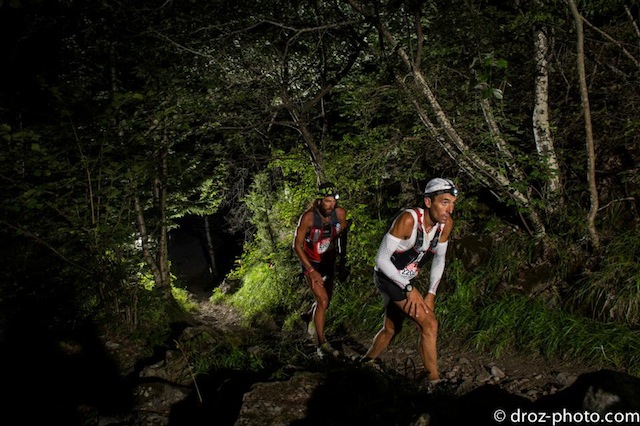
Following Miguel on the climb from Courmayeur to Bertone. Photo: Salomon Running/Damien Rosso.
Thus far, everything about the race had gone remarkably to plan.
While our pace was steady, it felt easy, so I was pretty sure we didn’t
really have that substantial of a lead, which was fine with me. I knew
it was still so early and the real racing was yet to begin. Despite
being determined to not push until at least the far side of Grand Col
Ferret (100km)—and ideally not until Champex Lac at mile 76—I
immediately gapped Miguel at the foot of the Col Ferret climb. The top
third of the climb was increasingly windy and foggy and I gradually felt
myself getting a little nauseous as well. I slowed my pace even further
as I fished around in my pack to don a jacket and then I kept it there
in an effort to keep my stomach happy. I was in the lead of the race but
still had 40mi to go so didn’t see any need to be pushing the pace at
all. I veritably strolled to the top of the pass then, nearly missing
the check-in tent in the fog, and started down the other side, happy to
get out of the cloud and into warmer air.
When I stopped about 10min below the summit to restow my jacket, I
was unsurprised when a headlamp came cruising by me—despite deliberately
taking it easy up the hill my hamstring was again noticeably checking
my abilities on the gradual downhill grade. I was surprised, however,
that the new leader was now Xavier and not Miguel. I couldn’t really
push in pursuit on the rest of the gradual descent into La Fouly, due to
my hamstring, but I was a bit surprised when Bryon Powell informed me
there that Xavier had grown his lead to 5min. On the flat road through
town, though, I had some very encouraging pep in my legs and was still
extremely optimistic about my chances of catching back up once we got to
the 1500′ climb up to Champex-Lac.

Leaving the Fouly aid station, 111km. Bryon Powell lurking. Photo: Ian Corless.
The next 4-5mi over to Praz de Fort are a continued net downhill, and
all the running was taking a real toll on my right hamstring. It was
super frustrating that I couldn’t push because of a simple mechanical
glitch in my leg, and when it came time to start making a move on the
climb to Champex I found that my left achilles was now also predictably
quite overworked from compensating for my hamstring.
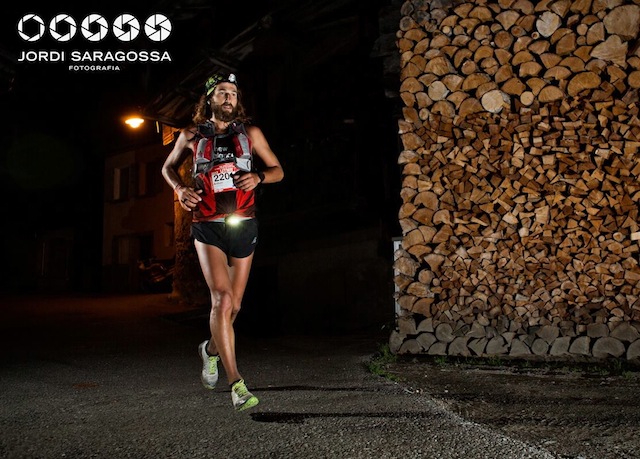
Praz de Fort (117km) and a stack of firewood, just before daybreak. Photo: Jordi Saragossa.
As a result, I couldn’t run this climb nearly as hard as I would’ve
liked—and had the energy to do—and I could sense that my ability to
actually race was rapidly disappearing. I ran into the Champex-Lac aid
tent with Miguel right on my heels, but it hardly mattered, I could only
gimp so fast at this point. In an attempt to change the stresses on my
legs and hopefully off-load my achilles a little I stopped to quickly
change shoes in the aid station, swapping out 110v1′s for 110v2′s with
additional heel lifts inserted.
Miguel and I exited the tent together and he was obviously hurting
but still had the energy to give me a knowing wink and wry smile as we
left the station. Miguel was the competitor I spent the most time with
during the race, and it was a pleasure to run with such a wily vet,
especially since our previous tandem racing experience had been cut
short at Cavalls del Vent last fall where he had succumbed to the rain
and cold. I was especially impressed with his UTMB performance this
year, since I had been witness to just how much effort he was putting
forth so early in the race (Courmayeur). On the run through the streets
of Champex along the shore of the lake, though, my hamstring wouldn’t
let me stride out enough to match his pace.

Hobbling out of Champex. Photo: Joe Grant.
However, the true hobbling didn’t start until we crested the hill on
the edge of town, and the course went gradually downhill for the next
couple of kilometers on a wide, smooth fire road. Miguel disappeared
into the distance, and I had a minor case of deja vu as this was exactly
where my hamstring had been the worst on my tour around the course two
weeks earlier. On that particular morning, Tim Olson’s wife Krista had
dropped me with ease in this very same spot.
The Bovine uphill is sections of flattish trail punctuated by much
steeper pitches that would normally deliver you at the summit in quite a
hurry. Not so today. The steep terrain was murder on my achilles and I
soon found myself actually walking backwards up the hill on the steepest
inclines. I stopped several times to loosen and re-tie my laces, trying
in vain to find some way to make my achilles operable. After what
seemed like ages, I finally made the summit and started down the other
side, but now, of course, my hamstring was in total rebellion and my
downhill progress was pathetic. This was doubly frustrating because even
with ~25k’ of descent on my legs, my quads were still rarin’ to go.
Javier Dominguez finally caught up to me on the descent as I was stopped
to re-tighten my shoe laces—I couldn’t believe that it took so long,
but I guess that’s just the way the game goes in the late stages of a
100mi. No one is moving particularly quickly (though I thought he was
running impressively well on the downhill at that point).
Eventually, I limped the rest of the way down the hill into Col de
Forclaz where Kilian and Emelie’s encouragement couldn’t even heal
things, and then just before Trient, Julien came running by (putting me
in 5th place) looking like he was on his way to recovery from a bad
patch. Once I finally gimped into the aid station, I stopped for a long
time to get my hamstring and achilles taped in a last-ditch effort in at
least being able to finish. Of course, things were far too gone for
taping to do much of anything at that point, and once I left the aid to
test things out I knew I was done. The medical person there was
concerned about my inflamed achilles and the possibility of rupture if I
continued on it, especially since I was now compensating like mad for
it.
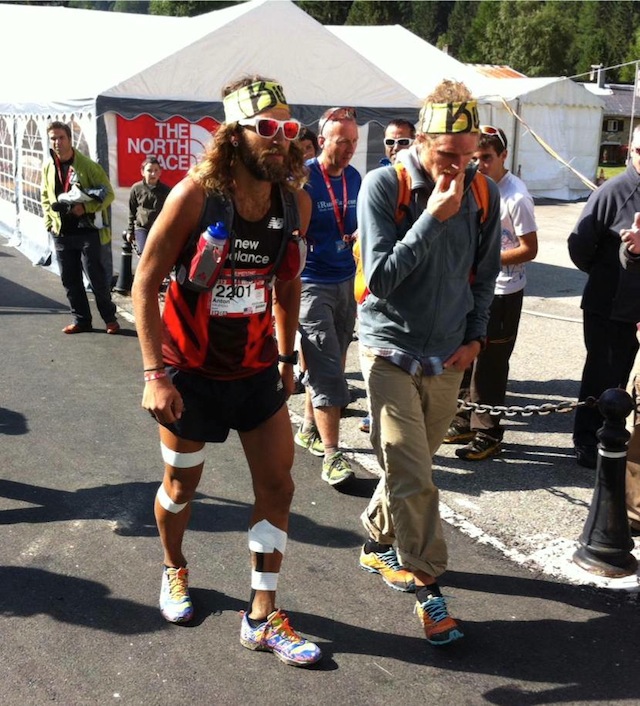
Leaving the Trient aid station (139km). Photo: Trails Endurance Magazine.
And that was my race.
Ultimately, the decision to drop wasn’t even really a decision. Now,
even with hindsight four days later, I have no regrets about it
(especially given the states of my hamstring and achilles now,
post-race). If I were to have a do-over on my whole trip to Europe, the
main thing I would change is touring around the mountain in, say, four
days instead of three, so that the stress on my body wasn’t so high.
There is no doubt that I’ll return to Chamonix in the future to give
UTMB another go, probably even next year. There are a lot of things
about the race that I find to be a big turn-off, but there’s no denying
that it is the pinnacle in 100mi mountain racing in terms of
international competition and profile. All of this talk about a 100mi
“championship” in the ultra community is really pretty redundant in my
eyes, because UTMB already exists. I feel the course is very
fair—non-technical, not at high-altitude, but enough climbing to keep it
honest. The organization accommodates entry for top athletes. The only
real issue with it, I think, is that it falls about two weeks too late
on the calendar. According to pretty much everyone I talked to, the
weather notoriously turns crappy the last week of August and is
predictably brilliant in the few weeks leading up to that. We lucked out
this year, but as the past five years have shown, this year’s weather
was an anomaly.
Finally, a tip of the proverbial hat must be given to Tim, Mike, and
Rory. Tim and Mike certainly didn’t have their best days on the hill,
but they soldiered on with grit and determination and found a way to get
it done, yet again. And as other’s have already noted, Rory’s run was
most likely the performance of the year on the women’s side.
As for me, priority number one is to get healthy, and I’ll make a
determination about UROC once I get home to Colorado next week and see
how my legs are responding to some running again. Thanks for everyone’s
support and following along, I’m as (probably more) aware as everyone
else what a rough go this summer has been on the performance front for
me, but I don’t plan on stopping trying any time soon.



